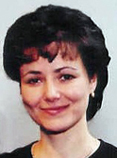Faculty
Inna Vernovsky, M.D.
Specialty: Pulmonary Medicine
Newton-Wellesley Hospital
2014 Washington Street
Newton, MA 02462
Publications
The following is a list of recent publications for which this Partners Asthma Center physician has been cited as an author in PubMed databases. Study abstracts have been provided for your convenience.
Mansharamani, N. G., D. Balachandran, et al. (2000). "Peripheral blood CD4 + T-lymphocyte counts during Pneumocystis carinii pneumonia in immunocompromised patients without HIV infection." Chest 118(3): 712-20.
STUDY OBJECTIVES: To assess the potential use of peripheral blood CD4 + T-lymphocyte counts (CD4 + counts) as a clinically useful biological marker to identify specific immunocompromised patients (without HIV infection) at high risk for Pneumocystis carinii pneumonia (PCP). DESIGN: Prospective observational study. SETTING: Three hundred seventy-five-bed tertiary-care urban referral teaching hospital, and 250-bed community-based referral hospital. PATIENTS: One hundred seventy-one consecutive confirmed HIV-seronegative hospitalized and ambulatory adults, including 22 patients with active PCP, 8 patients with bacterial pneumonia, 24 persons in two groups considered at high clinical risk, 38 persons in two groups considered at low or undefined risk, and 79 persons in four groups considered not at risk for PCP (including healthy individuals). MEASUREMENTS AND RESULTS: Compared to counts in healthy individuals, median CD4 + counts were significantly decreased in patients with active PCP (61 cells/microL vs 832 cells/microL; p = 0.001) where 91% of patients had a CD4 + count < 300 cells/microL at the time of PCP diagnosis. Median CD4 + counts were also reduced in the high clinical risk groups of recent organ transplant recipients (117 cells/microL; p = 0.007), 64% with < 300 cells/microL, and patients receiving chemotherapy (221 cells/microL; p<0.01), 80% with < 300 cells/microL. For the low or undefined clinical risk groups, the median CD4 + counts were not significantly reduced, although 39 to 46% of individuals receiving long-term corticosteroid therapy (alone or in combination with other agents) had CD4 + counts < 300 cells/microL. Median CD4 + counts in individuals considered not at risk for PCP were similar to those in healthy subjects. Compared to counts in patients with active PCP, median CD4 + counts were significantly higher in bacterial pneumonia patients (486 cells/microL; p<0.05), but similar to those in healthy subjects. CONCLUSIONS: These data suggest that for immunosuppressed persons without HIV infection (especially in low or undefined PCP risk groups), CD4 + counts may be a useful clinical marker to identify specific individuals at particularly high clinical risk for PCP and may help to guide chemoprophylaxis.
Levin, M. S., I. Vernovsky, et al. (1996). "Recent Dieulafoy's lesion bleeding and massive pulmonary emboli. Successful use of thrombolytic therapy." Chest 110(2): 567-70.
A massive GI bleed secondary to a Dieulafoy's lesion developed in a 77-year-old woman. Fifteen days later, massive pulmonary emboli developed. We describe successful thrombolytic treatment of her pulmonary emboli without complicating GI hemorrhage.

